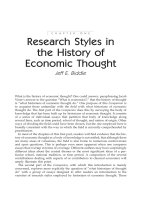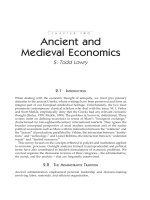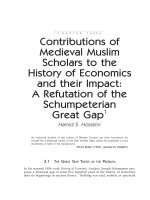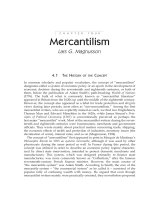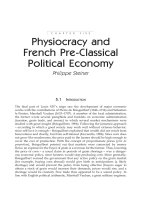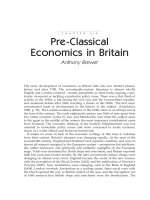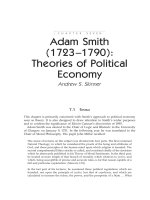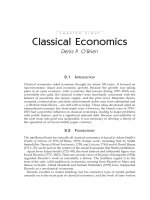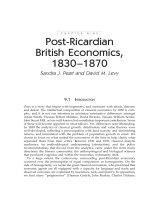A Companion to the History of Economic Thought - Chapter 22 ppsx
Bạn đang xem bản rút gọn của tài liệu. Xem và tải ngay bản đầy đủ của tài liệu tại đây (219.23 KB, 17 trang )
KEYNES AND THE CAMBRIDGE SCHOOL 343
CHAPTER TWENTY- TWO
Keynes and the
Cambridge School
G. C. Harcourt and Prue Kerr
22.1 INTRODUCTION
We start with Maynard Keynes’s central ideas. We then discuss the strands that
emerged in the work of others, some contemporaries, some followers, some agree-
ing and extending, others disagreeing and/or returning to ideas that Keynes
sloughed off or played down. The General Theory is the natural starting point.
We trace developments from and reactions to it, especially by people who were
associated, at least for part of their working lives, with Cambridge, England. In
the concluding paragraphs, we briefly discuss the contributions of those not
geographically located in Cambridge who nevertheless worked within the tradi-
tion of Keynes and the Cambridge school.
22.2 KEYNES AND THE CLASSICS
The General Theory emerged as a reaction to the system of thought, principally
associated with Alfred Marshall and A. C. Pigou, on which Keynes was brought
up and which he was to subsume, misleadingly, under the rubric of the classical
school. Keynes rationally reconstructed the classical system by setting out what,
though it could not be found in the writings of any one “classical” economist,
must have been assumed and developed if sense were to be made of their attitudes
and claims. (Keynes’s procedure could be equally well described as opportun-
istic.) In its most stark form, the classical system assumes a clear dichotomy
between the real and the monetary, with the real the dominant partner, at least
in the long period. In a competitive environment there is a tendency to market-
clearing in all markets (including the labor market), again, at least in the long
period. This determines the values of equilibrium normal long-period prices and
344 G. C. HARCOURT AND P. KERR
quantities, including those for the services of the factors of production. It also
provides the theoretical value of T in Irving Fisher’s version of the quantity
theory of money (QTM) (Y in Marshall’s version) and, together with the assump-
tion of an exogenous value of M and a given value of V(k), makes the general
price level (P) proportional to M. The natural rate of interest – a real concept
– equilibrates real saving and investment, determining the composition of
full-employment Y, itself determined by the full-employment equilibrium value
of employment in the labor market. The money rate of interest has to adjust to
the real rate, which rules the roost.
This is more a Marshallian than a Ricardian view of the world; it assumes
Say’s Law in a form in which the original classical political economists would
never have stated it, as far as full employment of labor (as opposed to capital) is
concerned.
This system underlay Keynes’s Tract and Treatise on Money, though Keynes
champed at the bit of its constraints, wishing to analyze short-period happenings
to production and employment and propose policies appropriate for other
than that long run in which we are all dead. Even in the Treatise on Money,
long-period stock and flow equilibrium and its attainment dominated the core
of the analysis. Keynes felt guilty analyzing short-period changes in output
and employment, but he did allow himself the banana plantation parable, the
analysis of which was incomplete because Kahn’s multiplier analysis had not yet
occurred.
These constraints were virtually completely removed in The General Theory.
The real-money dichotomy was discarded; money and financial matters entered
from the start of the analysis, fully integrated with real happenings. Money,
analytically, had all its dimensions – a store of value as well as a medium of
exchange and a unit of account. Emphasis moved from the long to the short
period. Keynes’s predilections in this regard were reinforced by the approach
and work of his favorite pupil, now colleague, Richard Kahn, whose King’s
fellowship dissertation, “The economics of the short period,” made the short
period worthy of study in its own right – though, as we shall see, it is not
unanimously agreed that The General Theory is or should be short period
in emphasis. The switch from saving determining investment to investment
determining saving, which was already occurring in Cambridge and elsewhere,
became complete in The General Theory. The money rate of interest, now the price
that equalized the demand for and supply of money, ruled the roost; the General
Theory version of the natural rate of interest, the mec (it should have been
the mei), had to measure up to it. The heretical concept of an unemployment
equilibrium or rest state, the point of effective demand, emerged as the central
proposition of The General Theory.
With Say’s Law refuted, QTM no longer explained the general price level.
Keynes substituted for it a macroeconomic version of Marshall’s short-period
supply curve. With marginal-cost pricing usually assumed to occur, there was an
upward-sloping relationship between activity and the general price level in any
given situation. Some of his closest colleagues and co-workers – Roy Harrod,
Kahn, Austin and Joan Robinson, Gerald Shove, and Piero Sraffa – had helped to
KEYNES AND THE CAMBRIDGE SCHOOL 345
develop the then emerging theory of imperfect competition. Keynes noted this
but did not think it of central importance for his new, different purposes – he
took as given the degree of competition. (Michal Kalecki showed in his review
article of The General Theory how right Keynes’s instinct was. Nevertheless, Kalecki
and, subsequently the post-Keynesians, for example, Nicholas Kaldor, Alfred
Eichner, G. C. Harcourt and Peter Kenyon, Sydney Weintraub, and Adrian Wood,
were to make mark-up pricing, replete with a theory of the determination of
its size, an integral part of the theories of employment and distribution.)
Crucially, Keynes’s philosophical views, developed while he was still an under-
graduate and most comprehensively expressed in his 1909 King’s fellowship
dissertation, A Treatise on Probability (subsequently published in 1921), are an
integral aspect of the complex analysis of The General Theory. We refer to the
modern writings on the significance of this in the concluding paragraphs.
We should also mention the sad happening that Keynes’s closest collaborator
in the development of monetary theory during the 1920s, Dennis Robertson,
parted company with him as The General Theory emerged. Robertson was shocked
by Keynes’s disrespect for his elders and betters (read Marshall). He thought the
policy implications were dangerous because Keynes’s analysis did not capture
the rich, inescapable dynamics of the interactions of the real and monetary
sectors of industrialized economies. They implied cyclical developments, around
which monetary and fiscal measures should attempt to fit like a glove but not try
to remove, in order to preserve the potential of long-term rises in productivity
and the standard of living generally. The rift was both a personal and professional
tragedy (a superb account of the psychological and intellectual reasons for it can
be found in Fletcher, 2000).
Kahn and Joan Robinson were always hostile to the IS–LM version of Keynes’s
system as it came down to the profession and the textbooks, principally through
J. R. Hicks’s famous 1937 article. They never said why in print, but it became
clear in the postwar period that they thought it cut out Keynes’s emphasis on
how an environment of inescapable uncertainty affected how (usually) sensible
people did the best they could when making economic decisions. They also
thought it impossible to properly set out Keynes’s new ideas within the frame-
work of Hicks’s adaptation of the Walrasian system. The latter underlay Value
and Capital (1939), written while Hicks was teaching in Cambridge in the second
half of the 1930s (it was conceived when he was at LSE), so that it was the natural
framework within which for him to try to understand Keynes’s new theory.
Keynes, Kahn, and Austin and Joan Robinson were always resolutely Marshallian
in method, even for macroeconomics. Yet passages in The General Theory – see, for
example, page 173 – may legitimately be interpreted in terms of IS–LM. They
show its great limitations as well as the basic insight that it gives (see Moggridge,
1976, pp. 171–4). The two relationships cannot be taken to be independent of
one another; changes in the value of a parameter underlying one may often
affect those underlying the other, leading to Keynes’s shifting equilibrium model
and to the modern analysis of path-dependence (which Kaldor initially set out
in 1934!). Several of Keynes’s closest allies did The General Theory in terms of
IS–LM, admittedly in algebra or words, not diagrams. Thus Brian Reddaway’s
346 G. C. HARCOURT AND P. KERR
review, and Harrod’s and James Meade’s contributions to the session at the
Oxford conference at which Hicks presented his paper are so set out. Indeed,
Hicks read Harrod’s and Meade’s papers before he wrote his and produced the
diagram (see Young, 1987).
22.3 KEYNES, KEYNESIANS, AND WORLD WAR II
Although a group of Keynesians dispute it (see pp. 351–2 below), those closest to
Keynes regarded Keynes’s core model as set in the short period. He was mostly
concerned with the employment-creating effects of investment expenditure and
virtually ignored its capacity-creating effects. He analyzed the conditions for the
establishment of a rest state that could be associated with unemployment in a
situation in which the existing stock of capital goods, supplies of skilled and
unskilled labor, the quantity of money, and the degree of competition were given.
He provided a sketchy analysis of the trade cycle in a later chapter and made
some asides about prospects for long-term growth (or their lack), but never sys-
tematically examined them in The General Theory itself. He set out policy proposals
for attaining full employment in the short term, starting from a deep slump but,
again, only sketched in the difficulties associated with sustaining full employ-
ment – Kalecki (1943) analyzed the crucial difference between the political economy
of getting to full employment and sustaining it. In wartime, Keynes and his ideas
played a major role in getting the British economy through World War II without
major inflationary problems. Keynes illustrated his theory’s generality in How to
Pay for the War (1940). There he introduced the concept of an inflationary gap –
aggregate demand in real terms exceeding full-employment aggregate supply
– and the steps to be taken to eliminate the gap to avoid prices rising, queues
forming, and order books lengthening.
During the war, two of Keynes’s closest associates, Meade and Richard Stone,
developed a comprehensive system of national accounts based on the relation-
ships in Keynes’s theory to help the war effort by avoiding bottlenecks and
shortages. Building on these foundations Stone developed the accounts uniformly
and internationally. (He received the Nobel Prize in 1984 for these “fundamental
contributions.” Meade received it in 1977 for his contributions to international
economics, also built on Keynesian foundations.) Economic historians – for
example, Alec Cairncross, Phyllis Deane, Charles Feinstein, and Brian Mitchell –
used the Keynesian system and national accounts to reinterpret aspects of the
Industrial Revolution and, in the case of Deane, to analyze the problems of devel-
oping countries.
22.4 GROWTH AND DISTRIBUTION
In the postwar period, Kahn, Joan Robinson, and Sraffa, stimulated by Harrod’s
seminal prewar and early postwar writings on growth (1939, 1948) and by the
problems of reconstruction and development generally, turned their attention to
“generalising The General Theory to the long period.” (They were later joined by
KEYNES AND THE CAMBRIDGE SCHOOL 347
Kaldor and then Luigi Pasinetti.) They reached back over the neoclassical inter-
lude of resource allocation and price theory generally to the preoccupations of
the classical political economists and Marx with growth, distribution, and the
role of technical progress, taking in the findings of the Keynesian revolution in
the process. Harrod posed two fundamental problems: first, the instability of his
warranted rate of growth, g
w
– the rate of growth which, if attained, would be
sustained because actual outcomes would persuade decision-makers concerning
accumulation that they were doing the correct rates of accumulation. If it were
not attained, the economy would give out destabilizing signals; the actual rate of
growth, g, would tend to move further and further away from g
w
in either
direction, depending upon whether g was greater than or less than g
w
. The
second problem was whether there were forces at work that could bring g
w
and g
n
together, where g
n
, the natural rate of growth, represented the supply
potential of the economy associated with the rates of growth of its labor supply
in quantity and quality. There was no reason why g
w
should equal g
n
, because
g
w
was concerned with accumulators achieving their desires, not wage-earners
necessarily being fully employed, as they would be on g
n
. The Cambridge Keyne-
sian growth theorists addressed these two basic problems. (John Cornwall, much
influenced by Kaldor’s approach in particular and unwilling to accept Harrod’s
assumption that g
n
was independent of g
w
, has over the past 40 years and more,
illuminated our understanding of the development of capitalist economies over
time by analyzing how g
w
and g
n
feed back into one another: see Harcourt and
Monadjemi, 1999.)
To illustrate significant differences in their approaches, we consider those of
Kahn and Joan Robinson, on the one hand, and Kaldor, on the other. Both devel-
oped macroeconomic theories of distribution. Kaldor called them “Keynesian”
because he found their origins in the passages in the Treatise on Money on the
widow’s cruse and because they incorporated the Keynesian view that invest-
ment led and saving responded to it. Kaldor initially argued that in the long
period the economy grew at full employment along g
n
; the role of the multiplier
was to determine the distribution of income between profits and wages, suppos-
ing that the marginal propensity to save from profits, s
II
, exceeded that from
wages, s
w
, and money prices were more flexible than money wages in the long
period. If the economy were not saving the right amount to allow the provision
of the accumulation needed to keep the economy on g
n
, the gap between planned
investment and saving would so change the distribution of income as prices
change more rapidly than money wages, as to bring about an overall saving ratio
equal to the required investment ratio in long-period full-employment income.
(In the 1930s, Kalecki developed a similar theory for the short period, but did not
require the economy to be at full employment. Saving therefore could be brought
to equality with investment by changes in income and its distribution, and the
resulting rest state could be associated with involuntary unemployment. More-
over, Kalecki explicitly linked pricing practices and their determinants in different
sectors of the economy to the distribution of income.)
Kahn and Joan Robinson developed their arguments in two stages. First, they
examined the properties of Golden Ages, so-called because they were mythical
348 G. C. HARCOURT AND P. KERR
states, never to be realized in reality. Their aim was to make precise certain
definitions – profits, capital, saving, investment – and relationships which could
only be made so in Golden Ages (or “steady states,” as the neoclassical growth
theorists called them) where expectations and actuality always matched. They
identified several variants of Golden Age, some with desirable properties, others
not, such as Bastard Golden Ages, with sustained unemployment of labor. They
then attempted to analyze processes occurring in historical time (as opposed to
the logical time of Golden Age analysis), never completely successfully. Indeed,
toward the end of her life, Joan Robinson sometimes despaired of ever achieving
this, though in one of her last papers (coauthored with Amit Bhaduri: see Bhaduri
and Robinson, 1980), she was less pessimistic than in her nihilistic paper of the
same year, originally entitled “Spring cleaning” (Robinson, 1985 [1980]). There
she argued that we should scrap everything and start anew.
Kaldor, though, was happy to use steady-state analysis in descriptive analysis
of the real world, making sense in explanations of the occurrence of his famous
“stylised facts” – near enough regularities over time to require explanation.
He wrote a series of papers in the 1950s and 1960s, starting from his famous
“Alternative theories of distribution” (1955–6). They were both Keynesian
and classical, because he now introduced a technical progress function relating
productivity growth to the rate of take-up through accumulation of the flow of
new ideas through time. In the most refined version, investment is specifically
related to embodiment at the margin of new ideas and to productivity growth.
All incorporate Kaldor’s (and, eventually, other Cambridge growth theorists’)
refusal to accept the neoclassical distinction between movements along a given
production function (deepening) and movements of the production function
due to technical progress. Kaldor regarded the distinction as incoherent – new
accumulation carried with it, indissolubly, new ways of making products and,
often, new products themselves.
Kaldor’s and Joan Robinson’s views were not that different from the pion-
eering work of Wilfred Salter on vintages in Productivity and Technical Change
(1960), except that, at any moment of time, the ex ante production function
of “best-practice” techniques was whittled down to one point, endogenously
created to meet the needs of the moment (in the light of expectations about
the future), while Salter allowed a choice of techniques to occur. Eventually,
Kaldor rejected this approach. He ultimately thought that the problems of
steady growth arose from the difficulty of keeping the growth of the availability
of primary products in line with the growth of the absorptive capacity of
the industrial sectors of the world. In his view neither the Keynesian nor the
neoclassical models could handle the complementarity of an integrated world.
A multi-sector model was required to tackle the mutual interdependence of the
sectors, where the development of each depends upon and is stimulated by
the development of others. Different pricing behavior as between the sectors
tended to frustrate the emergence of harmonious interdependence. Kaldor’s
approach has been developed by his biographer, Tony Thirlwall, often with John
McCombie (see, e.g., McCombie and Thirlwall, 1994). But we have run ahead of
our story.
KEYNES AND THE CAMBRIDGE SCHOOL 349
22.5 THE CAPITAL THEORY CRITIQUE
Simultaneously with these positive developments of classical cum Marxian cum
Keynesian ideas occurred a critique of the foundations of neoclassical value,
growth, and distribution theory associated with the so-called Cambridge con-
troversies in the theory of capital. Starting as an attack on the capital variable in
the aggregate production function, it developed, especially in the hands of Joan
Robinson and Kahn, into a critique of the long-period method – comparisons of
long-period positions with different values of a key parameter to analyze processes
occurring in actual time. Summed up in Joan Robinson’s phrase, “History versus
equilibrium,” it is the error of using differences to illuminate the results of changes.
Another strand of the critique was precipitated into the public domain by Joan
Robinson in 1953–4 (developed long before by Sraffa, it was revealed with the
publication of Production of Commodities in 1960.) It questioned the robustness
of the intuition that prices, including distributive prices, were reliable indexes
of scarcity. This intuition was refuted in the 1960s by the capital-reversing and
reswitching results. They destroyed the theoretical foundations of the inevitabil-
ity of a downward-sloping demand curve for capital (outside the domain of one
commodity models) and of negative relationships between the rate of profits (r),
on the one hand, and capital-output ratios and sustainable levels of consumption
per head, on the other. Indeed, the coherence of the concept of a marginal product
of capital (outside the one commodity domain) was called into question. The
marginal productivity theory of distribution became problematic, for reasons other
than those adduced within the neoclassical framework (see Mandler, 1999).
In the 1950s Kahn and Joan Robinson extended Keynes’s liquidity preference
theory of the rate of interest to take in the stock market, adding equities to bonds
as financial assets competing with the holding of money. They built on Keynes’s
1937 papers (see Keynes, 1937a,b) setting out his insight of the Treatise on Money,
lost sight of in The General Theory, that finance, not saving, was the ultimate
constraint on the rate of accumulation, provided that expected profits were buoyant.
(Depressed expected profits obviously bite in a slump, regardless of the state of
finance – hence Keynes’s pessimism about an effective role for easier credit terms
on their own in revival from a slump.) Also associated with these developments
were Kaldor’s seminal ideas from the late 1930s about the operation of markets
where stocks dominate flows and expectations of future price movements on
both sides of the market dominate the impact of the usual determinants of prices.
22.6 PIERO SRAFFA’S PRODUCTION OF COMMODITIES
Sraffa had started long before the 1950s on a critique of the foundations of the
neoclassical value and distribution theory. The first public inklings of this, as
Joan Robinson saw it, were in the 1951 Introduction to the Ricardo volumes
edited by Sraffa in collaboration with Maurice Dobb. She was then searching for
a satisfactory theory of the origin and size of the rate of profits in her emerging
work on growth theory. In the Introduction, Sraffa discussed Ricardo’s theory,
350 G. C. HARCOURT AND P. KERR
starting with a reconstruction, historical and rational, which involved the use of
a corn model to explain Ricardo’s early view that the profits of the farmer ruled
the roost. This was to be replaced in the Principles by a labor-embodied theory of
profits, an obvious link to Marx but without the concept of exploitation. (Smith
and Ricardo recognized the existence of class war and the lack of harmony in the
operation of capitalism.) Joan Robinson had been absorbing Marx’s messages
from the mid-1930s, encouraged first by her friendship with Kalecki and then in
order to take her mind off the war.
When Production of Commodities was published (1960), a few reviewers sensed
Sraffa’s twofold purpose – to provide a prelude to a refutation of the conceptual
and logical foundations of (neoclassical) economic theory and to revive the ap-
proach of the classical political economists and Marx to value and distribution
theory. The latter was intended to make possible a coherent theory of the laws of
motion of capitalist society, already potentially there in Marx’s writings, but with
errors removed and unfinished business completed. Such were the views of Dobb
(the leading Marxist economist of his generation in the UK) and Sraffa, Joan
Robinson (with reservations), Ronald Meek, and Kalecki. The core organizing con-
cept is the surplus – its creation, extraction, distribution, and use. In the book, Sraffa
examines production with a surplus in a system of single commodity industries;
the determination, first, of r and long-period relative prices when the value of
w is given and then of w and prices when the value of r is given; joint production
systems in order to analyze fixed capital; land, in order to take in price-determined
rent; and the choice of technique to complete the story and show the nonrobustness
of the intuition of price as an index of scarcity in distribution theory. The system
of Sraffa’s book is a rigorous representation of the structure of the centers of
gravitation associated with the natural prices of Smith and Ricardo and the prices
of production of Marx. It is not one side of Marshall’s demand and supply story
of the determination of long-period equilibrium normal prices (it has been so
interpreted by even such astute critics as Samuelson and Mandler).
Sraffa’s method is seen by Sraffians as the examination of the outcome of
persistent forces in establishing centers of gravitation of the economic system.
It incorporates the classical political economists’ insight that in a competitive
environment there is a tendency toward equality of profit rates in all activities;
thus a theory of the overall rate of profits to which they tend in value is needed,
a macroeconomic theory because it “could not be otherwise” (Pasinetti, 1962,
p. 277). It provides the basis for the revival of classical theory as well as a prelude
to a critique of neoclassical theory. The initial critique was spelt out in the capital
theory debates of the 1950s to 1970s (see Harcourt, 1972). Positive aspects of the
rehabilitation may be found in, for example, Heinz Kurz and Neri Salvadori’s
work on long-period production (1995).
22.7 LONG-PERIOD KEYNESIANS
Sraffa, though a close friend of Keynes, was not bowled over by The General
Theory. (He did defend Keynes’s Treatise on Money against Friedrich von Hayek’s
KEYNES AND THE CAMBRIDGE SCHOOL 351
attack, in the process using the concept of own rates of interest. Keynes used the
concept to play a key role in the crucial, difficult chapter 17 of The General Theory.
We suspect that Sraffa would not have approved, because he used the concept
in an internal critique of Hayek’s system, not to analyze actual economies.)
Sraffa’s followers embraced Keynes but argued that for his theory to be revolu-
tionary, he must provide (or have provided) a long-period theory of effective
demand purged of neoclassical leftovers in, for example, the mec of his investment
theory which, they argue, is vulnerable to the capital theory critique (not so,
according to Pasinetti). Murray Milgate (1982) is the most detailed argument for
this viewpoint but there are prior articles by, for example, Pierangelo Garegnani,
gathered together (including dissent from Joan Robinson) in the 1983 collection
edited by John Eatwell and Milgate.
22.8 LUIGI PASINETTI, RICHARD GOODWIN,
AND MICHAL KALECKI
The most original, ambitious, and sustained attempt to marry classical political
economy (as revived by Sraffa) and Keynes’s insights is found in the writings of
Pasinetti, senior heir to the “pure” post-Keynesian school of economic thought
now that the founding members are dead. His multi-sectoral growth model,
originally developed in his Cambridge Ph.D. dissertation in the 1950s and 1960s,
and reaching maturity in his 1981 book (and 1993 students’ guide), is a tour de
force. It absorbs Kahn’s and Joan Robinson’s Golden Age analysis, The General
Theory’s principal insights, Kaldor’s growth and distribution theories, and Sraffa’s
analysis of value, distribution, and production-interdependent systems. It takes
in the principal issues of what Baumol called the magnificent dynamics of clas-
sical political economy. A principal distinction stands out: Pasinetti’s insistence
that we understand the principles of an institution-free system before we take
into account the role of institutions and particular historical episodes. Pasinetti
illustrated this distinction in his discussion of the principle of effective demand
in Keynes’s theory (1997).
The method of the long-period Keynesians was never acceptable to Joan
Robinson and Kahn, or to Goodwin and Kalecki (who never explicitly engaged
with it). Joan Robinson experimented with the long period in a Marshallian
sense in the 1930s after The General Theory’s publication, to see whether Keynes’s
new results went through in this setting. She became increasingly dissatis-
fied with her findings, in the postwar period, repudiating Marshallian method
and concepts as such. Keynes was arguing by the early 1940s that long-period
equilibrium probably had no conceptual basis in his new theory. (He did not go
as far as Joan Robinson in spelling out why.) The really innovative developments
are associated with Kalecki and Goodwin. (Goodwin supervised Pasinetti’s
research in its early stages.) They increasingly refuted the notion of the trend
and cycle as separable concepts, brought about by nonoverlapping determinants.
Independently, they developed models of cyclical growth as characteristic of the
movement of capitalist economies. The basic idea was put succinctly (as ever)
352 G. C. HARCOURT AND P. KERR
by Kalecki: “The long-run trend [is] but a slowly changing component of a chain
of short-period situations . . . [not an] independent entity” (Kalecki, 1968; 1971,
p. 165). Goodwin, too, ultimately married production-interdependence models
(as well as Sraffa, Leontief was a mentor at the other Cambridge) with aggregate,
Keynes-type cyclical models that also had Marxian ingredients (he was Harrod’s
pupil at Oxford and Schumpeter’s colleague at Harvard) (see, e.g., Goodwin and
Punzo, 1987). Bhaduri and Joan Robinson (1980) entwined Kalecki and Marx
with Sraffa. Sraffa’s role was to provide thought experiments at a high level of
abstraction, resulting in an acceptable theory of the rate of profits.
22.9 FRANK HAHN AT CAMBRIDGE
We have concentrated on the writings of, mostly, those closest to Keynes (or his
ideas) as well as being influenced by the classicals and Marx, and becoming more
and more disillusioned with neoclassical economics. But we also mentioned how
others discerned in the IS–LM approaches the core of Keynes’s system, at least as
a starting point and a pedagogical device. Although the developments flowing
from this were deplored by the first group, this way of “doing” Keynes has been
most influential in teaching and the development of theory and policy. Some
developments occurred in Cambridge itself. Perhaps the most original is asso-
ciated with Frank Hahn (in his LSE Ph.D. thesis, published years later in 1972; he
came to Cambridge in 1960). Hahn modified the IS portion of Hicks’s apparatus
to take in a macroeconomic theory of distribution in which the marginal pro-
pensity to save from profits exceeded that from wages and induced investment
levels had to be matched by corresponding voluntary savings. This implied a
relationship between income levels and the share of profits. He married this with
a supply-side story whereby entrepreneurs, operating in an uncertain environ-
ment, could only be persuaded to accumulate at a rate that made the income
levels feasible and to organize production and employment so as to bring them
about if they received certain shares of national income as profits. The intersec-
tion of the two relationships was a stable, short-period rest state for income and
distribution.
In Cambridge, Hahn collaborated with Robin Matthews to write a survey
article on growth theory (1964), the role model for surveys ever afterwards.
Matthews also published two books on the trade cycle that were Keynesian in
their orientation, one an historical study, the other a wide-ranging textbook in
the Cambridge Economic Handbooks series. The second book was full of original
ideas. One of the most innovative came from his 1950s study of the saving
function and the problem of trend and cycle. He reinterpreted Duesenberry’s
ratchet effect by relating spending and saving to previous lowest levels of
unemployment in booms (rather than highest levels of income) so that the growth
in productivity was taken into account. He also wrote on the financial aspects of
the Keynesian multiplier working out over time.
After an interlude on general equilibrium theory and giving his name to a
process in growth theory, Hahn became a leading critic of monetarism and the
KEYNES AND THE CAMBRIDGE SCHOOL 353
New Classical macroeconomics of the 1970s on. He was aghast at their policies
and even more so at what he regarded as their intellectual dishonesty in claim-
ing that their theoretical analysis of how the economy worked justified their
proposed policies. Although he never understood Marx, we think he would
have had some sympathy with Thomas Balogh’s quip that monetarism was the
incomes policy of Karl Marx. In the 1980s and, with Robert Solow, in the 1990s,
he courageously criticized the monetarists from within, attempting to provide
alternatives which, using modern theoretical methods, came up with Keynes-
type results (Hahn and Solow, 1995). But there are none so blind . . . ; we fear that
their work has been ignored by those they attacked and by their potential allies,
the post-Keynesians.
22.10 RICHARD STONE AND JAMES MEADE IN THE POSTWAR YEARS
Stone, the first Director (1945–55) of the Department of Applied Economics (DAE),
developed in collaboration with J. A. C. Brown an eclectic growth model which
was nevertheless inspired by Keynes’s original ideas. Known as the Cambridge
Growth Project, the aim was to design a model that allowed the expenditure
and production-interdependence of the British economy to be tracked over the
medium to longer term under different scenarios. Its origin was Brown’s sugges-
tion that they bring together previous work in the DAE on social accounting,
input–output, and consumer behavior to build such a model for the British
economy. (The complementarity with Pasinetti’s contributions is not fanciful.)
David Champernowne (Keynes’s pupil when Keynes was writing The General
Theory) also made fundamental contributions in the postwar period in his own
independent way to our understanding of Keynes’s theory in the short and long
periods, and to growth and distribution theory.
We must also document Meade’s postwar writings, not only on international
trade (in a Keynesian setting) at LSE but also on growth theory when he suc-
ceeded Robertson in the Chair of Political Economy in 1957. His growth theory
was neoclassical in the Solow/Swan sense, but he never forgot his Keynesian
credentials. As with Solow and Swan (who never forgot their’s either), he
assumed that short-period effective demand puzzles had been taken care of by
an all-wise government, so that the long-period effects of substitution between
the factors of production responding to changes in the prices of their services and
the effects of technical progress could be analyzed. As a side issue, Meade (some-
times with Hahn) clarified some of the issues raised in Pasinetti (1962), on the
dependence of the long-period rate of profits solely on the saving propensity of a
class of pure capitalists and the natural rate of growth. Meade’s 1966 note, using
geometry superbly as ever, allows the reader/viewer to discover easily the prop-
erties of Pasinetti Land and its dual MSM Land, where Harrod-type ideas rule and
the capitalist class has ceased to exist. (MS stands for Modigliani and Samuelson,
who wrote a long paper on the issues, while M stands for Meade.) In the 1980s
Meade, in collaboration with a number of younger colleagues, worked on stab-
ilization policies, incorporating the techniques of control engineering. (Meade
354 G. C. HARCOURT AND P. KERR
was a great supporter of Bill Phillips’s pioneering work on these issues with these
techniques at LSE in the 1940s, 1950s, and after.) Meade’s last book, published
just before his death in 1995, was concerned with policies directed at the attain-
ment of full employment and a just distribution of income and wealth: a fitting
endpoint for a lifetime of service and decency, steeped in Keynes’s tradition.
22.11 KALDOR AND KEYNES’S MANTLE
The person at postwar Cambridge who most took on Keynes’s mantle was
undoubtedly Nicholas Kaldor. We have referred to his contributions to growth
theory in which, initially, the Keynesian influence was strong. But it was within
the framework of Keynes’s own system that he made the most direct contribu-
tions, including an internal critique of details of the system. First, Kaldor could
not accept Keynes’s microeconomic foundations of, in the main, Marshallian
marginal cost pricing. In its place, Kaldor put his representative firm/industry
model of a price-leading and -setting oligopolist surrounded by followers. In
the 1960s and 1970s he developed aspects of these views, on their own and in
macroeconomic settings, providing fertile suggestions for future research. (Wood’s
1975 book is the most direct heir.) Kaldor’s objections were related to his lifelong
preoccupation with cumulative causation processes and his appreciation of an
all-pervading influence of increasing returns, especially in manufacturing indus-
try, so that he could not accept atomistic competition as a general pricing model
(outside primary industries). Secondly, he thought that Keynes made a tactical
mistake by departing from his otherwise lifelong view to treat the money supply
in The General Theory as exogenous, not endogenous, or at least given (probably
what Keynes did). This is a mistaken view of how the banking system and the
Central Bank operated. It also proved to be a hostage to fortune as monetarists
grew more and more influential. Kaldor was one of the few UK voices in the
wilderness taking them on. He was a pioneer of the view that the money supply
is endogenous, that it is overwhelmingly demand that creates the money supply.
Here he was joined by James Trevithick, who also continued the Keynesian
tradition in teaching and in two classic texts, on inflation and involuntary unem-
ployment respectively. Like Keynes, Kaldor was active in policy – advising the
UK Labour governments in the 1960s and 1970s and international governments
too, sometimes with unexpected and startling results.
22.12 OTHER CAMBRIDGE CONTRIBUTORS IN THE POSTWAR YEARS
Another Cambridge economist who made seminal contributions in similar areas
is Robin Marris. The Economic Theory of “Managerial” Capitalism (1964) is a highly
original account of modern firm behavior, the path-breaking aspects of which
are now being fully realized. His 1980s and 1990s writings on imperfectly com-
petitive foundations of the Keynesian system are also strikingly original and
controversial – he argues that only these microfoundations allow Keynes’s
macroeconomic results to go through.
KEYNES AND THE CAMBRIDGE SCHOOL 355
Bob Rowthorn published the seminal paper on conflict inflation in 1977. It
is the starting point in the modern literature for discussions of this process, the
idea that sustained rates of inflation bring about an uneasy truce between capital
and labor. Both fail to achieve completely their aspirations for accumulation and
standards of living respectively.
What of Austin Robinson, who worked so closely with Keynes for many years
(and whose 1947 obituary article of Keynes is required reading alongside the
subsequent biographies – Harrod, Moggridge, and Robert Skidelsky’s unmatchable
three volumes)? Austin was an applied political economist par excellence. Armed
with his deep and astute understanding of Marshall, Pigou, and Keynes, and
with his wide knowledge of the real world in developed and developing countries,
in government service, and as an advisor, he devoted much time in the postwar
period to development problems. (Austin also stressed what he considered to be
a neglected aspect of postwar Keynesian developments, detailed analysis and
knowledge of individual firm and industry behavior, and of regional problems.)
In his writings on developing economies he made wise diagnoses and put forward
sensible, practical humane policy proposals that took into account the detailed
cultural and sociological characteristics of the societies and the aspirations of all
their citizens. In these pursuits he was joined by Brian Reddaway, whose writings
on development and on the British economy reflect a similar highly intelligent,
practical approach. Reddaway succeeded Stone as Director of the DAE in 1955;
he did and supervised applied work that was clearly Keynesian-inspired in its
approach and theoretical structure. Reddaway (who succeeded Meade in the
Chair of Political Economy) was succeeded at the DAE by Wynne Godley. With
Frances Cripps, other DAE officers, and Robert Neild, Godley brought an amalgam
of Marshall and Keynes to his view of how the UK economy works and how to
forecast in the short term. He developed a consistent set of flow and stock con-
straints associated with the interrelationship of real flows and stocks and their
financial counterparts. These had their origins in Keynes’s theory and the charac-
teristics of Marshall’s long period, modified for macroeconomic analysis.
Finally, we mention the highly original approaches of Ajit Singh to development
problems, Frank Wilkinson to the understanding of the labor market, and Tony
Lawson to methodological and philosophical issues, all of which add considerably
to the traditions and achievements of Keynes and the Cambridge school. Singh is
a major spokesman for views that are a creditable and decent alternative to those
of the so-called Washington consensus on development strategies. Wilkinson has
analyzed in much detail the functioning of labor markets, both individually and
in relation to the economy as a whole. He takes an historical and institutional
perspective, and shows great sympathy and understanding for wage-earners and
unions. Lawson’s writings on critical realism and open systems, vestiges of which
he discerns in Keynes’s writings, have opened up an international debate on the
legitimacy of mainstream theory and econometric practice. They assume a closed
system. Lawson argues that a discipline such as economics should be concerned
with analysis of an open system.
With the retirement and then death of many of the main dramatis personae, the
Cambridge Faculty has become more and more a clone of leading US schools.
356 G. C. HARCOURT AND P. KERR
The traditions outlined here are still carried on by a besieged minority, mostly
centered around the Cambridge Journal of Economics. Some still have a foothold
in the Faculty; others form a thriving colony in the Judge Institute of Manage-
ment Studies or are scattered around in colleges, as college, not university,
teachers. More optimistically, in centers other than Cambridge, Keynes and
the Cambridge tradition are to be found under the wide embracing rubric of
post-Keynesianism.
22.13 THE CAMBRIDGE TRADITION IN OTHER CENTERS
We think especially of the writings of the late Athanasios (Tom) Asimakopulos,
Avi Cohen, John and Wendy Cornwall, Omar Hamouda, Marc Lavoie, Tom
Rymes, and – most of all – the late Lorie Tarshis in Canada; the late Keith
Frearson, Robert Dixon, Peter Groenewegen, the essay’s authors (when there!),
Joseph Helevi, John King, Peter Kriesler, John Nevile, Ray Petrides, Colin Rogers
(and his South African countryperson, Christopher Torr), Trevor Stegman, Michael
White, and others in Australia; the late George Shackle, Philip Arestis, Victoria
Chick, Sheila Dow, Douglas Mair, Peter Reynolds, Peter Riach, Malcolm Sawyer,
Ian Steedman, and others in the UK; and of the late Sidney Weintraub, Allin
Cottrell, Paul Davidson, Sandy Darity, Amitava Dutt, Gary Dymski, the late Al
Eichner, John Kenneth Galbraith (and son James), Rick Holt, Jan Kregel, Michael
Lawlor, Fred Lee, Stephen Marglin, the late Hyman Minsky, Basil Moore, Edward
Nell, Steve Pressman, Roy Rotheim, Nina Shapiro, the late Paul Wells, and others
in the USA.
There are strongholds in continental Europe, particularly for those who were
influenced by Piero Sraffa, as well as by Keynes. We have mentioned Garegnani
and Pasinetti in Italy. We add Alessandro Roncaglia, Neri Salvadori, Claudio
Sardoni, Roberto Scazzieri, and Paolo Sylos-Labini (and many others of course).
In Germany, Bertram Schefold is a major Sraffian scholar, as were Heinz Kurz
and Christian Gehrke (they are now in Austria). There are other major contrib-
utors in Austria, especially Michael Landesmann, Kurt Rothschild, and the late
Josef Steindl. In Switzerland, Mauro Baranzini has written fine books and essays
that especially reflect Pasinetti’s approach. Heinrich Bortis’s magnificent mono-
graph (1997) is a synthesis of the main strands of thought to be found under the
post-Keynesian rubric; it exhibits a humane political philosophy and provides
a guide to effective, decent policies. In India, Amit Bhaduri, the late Krishna
Bharadwaj, and their colleagues, especially at JNU, and the late Sukhamoy
Chakravarty at the Delhi school have made major contributions to the tradition.
In addition, they applied the approach in their deep understanding of economic
and political processes in developing economies. Pervez Tahir in Pakistan
critically evaluated Joan Robinson’s writings on development in general and
China in particular. In Central and Latin America (especially in Brazil), pupils of
Davidson, Harcourt, Kalecki, and Marglin are making significant contributions
broadly within the tradition described in the essay.
KEYNES AND THE CAMBRIDGE SCHOOL 357
22.14 ECONOMICS AND PHILOSOPHY
Most important for our present purposes is the work of the past three decades on
the links between Keynes’s philosophy and his economics. Many seminal writings
on these themes started their lives as Ph.D. dissertations in Cambridge – Rod
O’Donnell, Anna Carabelli, John Coates, Flavio Comim, and Jochen Runde, for
example. An early, influential volume, edited by Lawson and Hashem Pesaran,
was published in 1985. Subsequently, John Davis published a major monograph
(1994a) and edited a major volume (1994b) on similar themes.
Three crucial aspects of Keynes’s economic writings, especially in The General
Theory and after, emanate from his philosophical understanding. The first is the
realization that in the operation of an economic system, the whole may be more
than the sum of the parts – hence his emphasis on the need in macroeconomic
analysis to avoid the fallacy of composition, a lesson largely forgotten as repres-
entative agent models have come to dominate modern analysis. The second is
that in a discipline such as economics there is a whole spectrum of relevant
languages, according to which issues, or aspects of issues, are discussed. It runs
from intuition and poetry through lawyer-like arguments to formal logic and
mathematics. All have rightful places; none should have a monopoly – truth does
not only come in the guise of a mathematical model. The third (derived from
Marshall) is that we need to analyze how (usually) sensible people decide in
situations of inescapable uncertainty, the one sure constant of all economic life
and therefore another “incontrovertible” proposition of our “miserable subject”
(Keynes to Bertil Ohlin, April 29, 1937; see Keynes, 1973, p. 190).
Note
We thank, but in no way implicate, the editors for their comments. We are indebted to
Sheila Dow for allowing us to see a draft of her essay, “Postwar heterodox economics:
Post Keynesian economics.”
Bibliography
Bhaduri, A. and Robinson, J. 1980: Accumulation and exploitation: an analysis in the
tradition of Marx, Sraffa and Kalecki. Cambridge Journal of Economics, 4, 103–15.
Bortis, H. 1997: Institutions, Behaviour and Economic Theory. A Contribution to Classical-
Keynesian Political Economy. Cambridge, UK: Cambridge University Press.
Davis, J. B. 1994a: Keynes’s Philosophical Development. Cambridge: Cambridge University
Press.
—— (ed.) 1994b: The State of Interpretation of Keynes. Boston: Kluwer.
Eatwell, J. and Milgate, M. (eds.) 1983: Keynes’s Economics and the Theory of Value and
Distribution. London: Duckworth.
Fletcher, G. 2000: Understanding Dennis Robertson. The Man and His Work. Cheltenham, UK
and Northampton, MA: Edward Elgar.
Goodwin, R.M. and Punzo, L. F. 1987: The Dynamics of a Capitalist Economy. A Multi-
Sectoral Approach. Cambridge, UK: Polity Press.
358 G. C. HARCOURT AND P. KERR
Hahn, F. H. 1972: The Share of Wages in the National Income. London: Weidenfeld and
Nicolson.
—— and Matthews, R. C. O. 1964: The theory of economic growth: a survey. Economic
Journal, 74, 779–902.
—— and Solow, R. M. 1995: A Critical Essay on Modern Macroeconomic Theory. Oxford:
Blackwell.
Harcourt, G. C. 1972: Some Cambridge Controversies in The Theory of Capital. Cambridge, UK:
Cambridge University Press.
—— and Monadjemi, M. 1999: The vital contributions of John Cornwall to economic theory
and policy: A tribute from two admiring friends on the occasion of his 70th birthday.
In M. Setterfield (ed.), Growth, Employment and Inflation. Essays in Honour of John Corn-
wall. Basingstoke, UK: Macmillan, 10–23.
Harrod, R. F. 1939: An essay in dynamic theory. Economic Journal, 49, 14–33.
—— 1948: Towards a Dynamic Economics. London: Macmillan.
Hicks, J. R. 1937: Mr. Keynes and the “classics.” Econometrica, 5, 147–59.
—— 1939: Value and Capital. Oxford: The Clarendon Press.
Kaldor, N. 1955–6: Alternative theories of distribution. Review of Economic Studies, 23,
83–100.
Kalecki, M. 1943: Political aspects of full employment. Political Quarterly, 14, 322–31. Re-
printed in Kalecki (1971), op. cit., pp. 138–45.
—— 1968: Trend and business cycles reconsidered. Economic Journal, 78, 263–76.
Reprinted in Kalecki (1971), op. cit., pp. 165–83.
—— 1971: Selected Essays on the Dynamics of the Capitalist Economy 1933–1970. Cambridge,
UK: Cambridge University Press.
Keynes, J. M. 1937a: Alternative theories of the rate of interest. Economic Journal, 47. Re-
printed in Keynes (1973), op. cit., pp. 201–15.
—— 1937b: The “ex ante” theory of the rate of interest. Economic Journal, 47. Reprinted in
Keynes (1973), op. cit., pp. 215–23.
—— 1940: How to Pay for the War. London: Macmillan. Reprinted in Keynes, J. M. 1972: The
Collected Writings of John Maynard Keynes, vol. IX, Essays in Persuasion, ed. D. Moggridge.
London: Macmillan, pp. 367–439.
—— 1973: The Collected Writings of John Maynard Keynes, vol. XIV, The General Theory and
After. Part II. Defence and Development, ed. D. Moggridge. London: Macmillan.
Kurz, H. D. and Salvadori, N. 1995: Theory of Production. A Long-Period Analysis. Cam-
bridge, UK: Cambridge University Press.
Lawson, T. and Pesaran, H. (eds.) 1985: Keynes’ Economics: Methodological Issues. London:
Croom Helm.
Mandler, M. 1999: Dilemmas in Economic Theory. Oxford: Oxford University Press.
Marris, R. L. 1964: The Economic Theory of “Managerial” Capitalism. London: Macmillan.
McCombie, J. S. L. and Thirlwall, A. P. 1994: Economic Growth and the Balance-of-Payments
Constraint. Basingstoke: Macmillan.
Meade, J. E. 1966: The outcome of the Pasinetti process: a note. Economic Journal, 76,
161–5.
Milgate, M. 1982: Capital and Employment. A Study in Keynes’s Economics. London: Aca-
demic Press.
Moggridge, D. E. 1976: John Maynard Keynes. Harmondsworth: Penguin.
Pasinetti, L. L. 1962: Rate of profit and income distribution in relation to the rate of
economic growth. Review of Economic Studies, 29, 267–79.
—— 1981: Structural Change and Economic Growth. Cambridge, UK: Cambridge University
Press.
KEYNES AND THE CAMBRIDGE SCHOOL 359
—— 1993: Structural Economic Dynamics. Cambridge, UK: Cambridge University Press.
—— 1997: The principle of effective demand. In G. C. Harcourt and P. A. Riach (eds.),
A “Second Edition” of The General Theory, vol. I. London: Routledge, 93–104.
Robinson, E. A. G. 1947: John Maynard Keynes 1883–1946. Economic Journal, 57, 1–68.
Robinson, J. 1953–4: The production function and the theory of capital. Review of Eco-
nomic Studies, 21, 81–106.
—— 1985 [1980]: The theory of normal prices and reconstruction of economic theory.
In G. R. Feiwel (ed.), Issues in Contemporary Macroeconomics and Distribution. London:
Macmillan, 157–65. The original 1980 paper was entitled “Spring cleaning.”
Rowthorn, R. E. 1977: Conflict, inflation and money. Cambridge Journal of Economics, 1,
215–39.
Salter, W. E. G. 1960: Productivity and Technical Change. Cambridge, UK: Cambridge Uni-
versity Press.
Sraffa, P. 1951: Introduction. In The Works and Correspondence of David Ricardo, Vol-
ume I, On the Principles of Political Economy and Taxation, edited by P. Sraffa with the
collaboration of M. H. Dobb. Cambridge, UK: Cambridge University Press, xiii–lxii.
—— 1960: Production of Commodities by Means of Commodities. Prelude to a Critique of Eco-
nomic Theory. Cambridge, UK: Cambridge University Press.
Wood, A. 1975: A Theory of Profits. Cambridge, UK: Cambridge University Press.
Young, W. 1987: Interpreting Mr. Keynes. Cambridge, UK: Polity Press.

